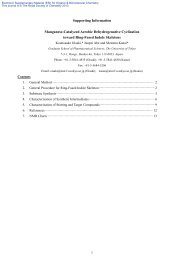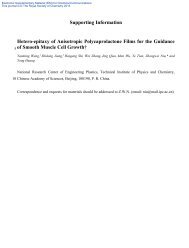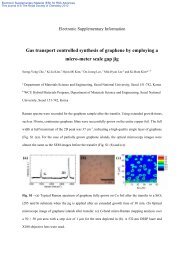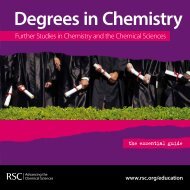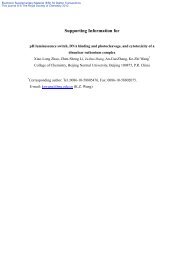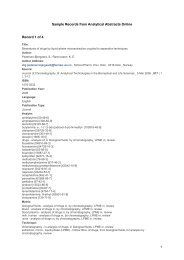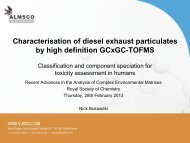Atom and molecule: upper secondary school French students ...
Atom and molecule: upper secondary school French students ...
Atom and molecule: upper secondary school French students ...
You also want an ePaper? Increase the reach of your titles
YUMPU automatically turns print PDFs into web optimized ePapers that Google loves.
A. Cokelez <strong>and</strong> A. Dumon 122<br />
As far as <strong>molecule</strong>s are concerned, the model of a covalent bond has been already<br />
introduced, <strong>and</strong> ball <strong>and</strong> stick models appear. Each stick between atoms can then be<br />
associated with a shared electron pair.<br />
The interpretation of the geometry of some simple <strong>molecule</strong>s is based on taking into<br />
account the repulsion of shared <strong>and</strong> unshared electron pairs around the central atom.<br />
Grades 11 <strong>and</strong> 12<br />
In grade 11, the representation of <strong>molecule</strong>s with the use of molecular models is<br />
generalized in organic chemistry. What is new is the introduction of the polar character of<br />
some bonds, <strong>and</strong> of polar <strong>molecule</strong>s.<br />
Lastly, it is only towards the end of the Physics curriculum in grade 12 that the Bohr<br />
model is introduced. It will thus not appear in our study.<br />
Analysis of <strong>students</strong>' evolving representations of atoms <strong>and</strong> <strong>molecule</strong>s<br />
Review of the literature<br />
While very few studies have been carried out in this field in France, a lot of research has<br />
been conducted in Anglophone countries (UK, Australia, NZ, <strong>and</strong> Canada). Here, we present<br />
the main findings relevant to our work.<br />
Conceptions of the atom<br />
An atom is often described as round, solid, hard (Griffiths <strong>and</strong> Preston, 1992; Harrison<br />
<strong>and</strong> Treagust, 1996) <strong>and</strong> defined as a ‘ball’ or ‘sphere’ (Harrison <strong>and</strong> Treagust, 1996).<br />
Therefore, the water <strong>molecule</strong> consists of two or more solid spheres (Griffiths <strong>and</strong> Preston,<br />
1992).<br />
Charlet-Brehelin (1998) shows that only slightly over a third of <strong>students</strong> who have<br />
followed a traditional course of studies <strong>and</strong> have left Lower Secondary School (beginning in<br />
grade 10) have internalised the minimum formulation level required at the end of grade 9: an<br />
atom is made of a nucleus <strong>and</strong> electrons (electron suite). An identical observation is brought<br />
out by Harrison <strong>and</strong> Treagust, (1996). Students generally produce four categories of models:<br />
the atom as a sphere, solar system atom, neutral atom (positive charges of the nucleus equal<br />
to negative charges of the electrons), <strong>and</strong> the atom as a nucleus surrounded by an electron<br />
cloud. By the end of a traditional course of studies, the first two models are used by many<br />
<strong>students</strong>, 41% <strong>and</strong> 48% respectively (Charlet-Brehelin, 1998). According to Harrison <strong>and</strong><br />
Treagust, (1996), many <strong>students</strong> represent an atom as a ‘simple circle’ within a large circle.<br />
Even after teaching, there remains among <strong>students</strong> a certain degree of confusion between the<br />
terms used: not only particle, atom, <strong>molecule</strong>, but also nucleus, proton, neutron <strong>and</strong> electron<br />
<strong>and</strong> their interrelationships (Osborne <strong>and</strong> Freyberg, 1985; Johnston, 1988). For some<br />
<strong>students</strong>, the number of electrons, protons <strong>and</strong> neutrons is the same for a given atom (Tsai,<br />
1998). Keig <strong>and</strong> Rubba (1993) reveal that for many <strong>students</strong> (45%), electrons are preassembled<br />
in electron pairs within the atom. According to Taber (1998) <strong>and</strong> Robinson (1998),<br />
<strong>students</strong> use the rule of octet as a basic heuristic principle, to explain chemical bonding,<br />
chemical reaction <strong>and</strong> ion formation. An atom is said to be stable if its valence shell is filled,<br />
<strong>and</strong> is said to be unstable otherwise. The quantum model of the atom gives birth to the<br />
representation of the electron cloud. But the fact that the <strong>students</strong> are willing to use this<br />
representation at the end of grade 9 (Charlet-Brehelin, 1998) is no guarantee that they<br />
underst<strong>and</strong> its meaning. Harrison <strong>and</strong> Treagust (1996 <strong>and</strong> 2000) show that, for <strong>students</strong>, the<br />
electron cloud is considered as a matrix in which electrons are embedded (as water drops in a<br />
cloud) <strong>and</strong> Tsaparlis <strong>and</strong> Papaphotis (2002) report that <strong>upper</strong> <strong>secondary</strong> Greek <strong>students</strong>’<br />
(grade 12) have greater difficulties in underst<strong>and</strong>ing the concept of ‘atomic orbital’.<br />
Chemistry Education Research <strong>and</strong> Practice, 2005, 6 (3), 119-135<br />
This journal is © The Royal Society of Chemistry




